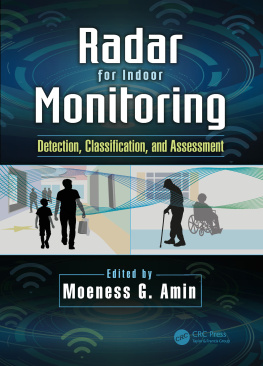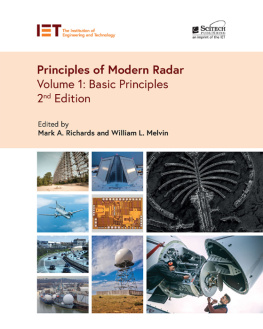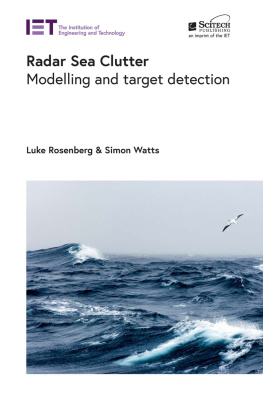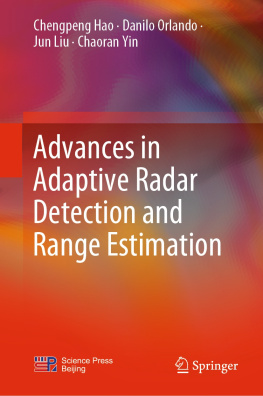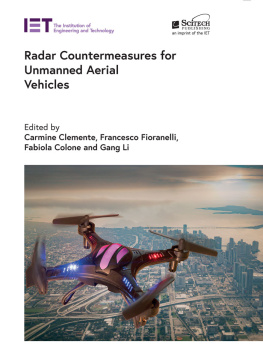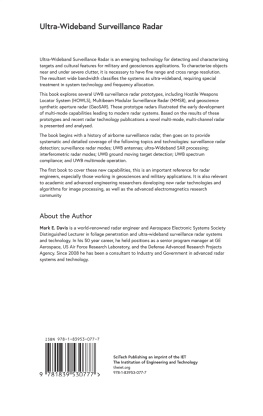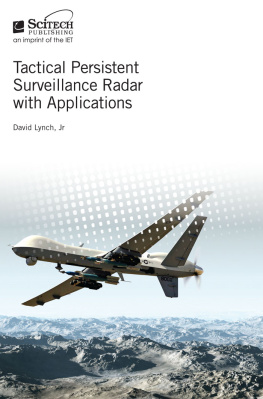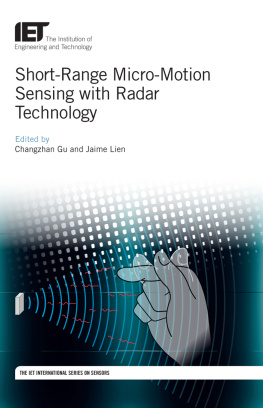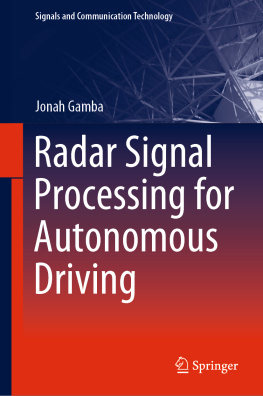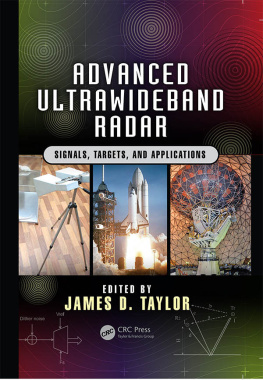Contents
Page List
Guide

Radar for Indoor Monitoring
Radar for Indoor Monitoring
Detection, Classification, and Assessment
Edited by
Moeness G. Amin

CRC Press
Taylor & Francis Group
6000 Broken Sound Parkway NW, Suite 300
Boca Raton, FL 33487-2742
2018 by Taylor & Francis Group, LLC
CRC Press is an imprint of Taylor & Francis Group, an Informa business
No claim to original U.S. Government works
Printed on acid-free paper
International Standard Book Number-13: 978-1-1387-4609-1 (Paperback)
International Standard Book Number-13: 978-1-4987-8198-5 (Hardback)
This book contains information obtained from authentic and highly regarded sources. Reasonable efforts have been made to publish reliable data and information, but the author and publisher cannot assume responsibility for the validity of all materials or the consequences of their use. The authors and publishers have attempted to trace the copyright holders of all material reproduced in this publication and apologize to copyright holders if permission to publish in this form has not been obtained. If any copyright material has not been acknowledged please write and let us know so we may rectify in any future reprint.
Except as permitted under U.S. Copyright Law, no part of this book may be reprinted, reproduced, transmitted, or utilized in any form by any electronic, mechanical, or other means, now known or hereafter invented, including photocopying, microfilming, and recording, or in any information storage or retrieval system, without written permission from the publishers.
For permission to photocopy or use material electronically from this work, please access www.copyright.com (http://www.copyright.com/) or contact the Copyright Clearance Center, Inc. (CCC), 222 Rosewood Drive, Danvers, MA 01923, 978-750-8400. CCC is a not-for-profit organization that provides licenses and registration for a variety of users. For organizations that have been granted a photocopy license by the CCC, a separate system of payment has been arranged.
Trademark Notice: Product or corporate names may be trademarks or registered trademarks, and are used only for identification and explanation without intent to infringe.
Visit the Taylor & Francis Web site at
http://www.taylorandfrancis.com
and the CRC Press Web site at
http://www.crcpress.com
Contents
Aboulnasr Hassanien and Braham Himed
aatay Tokgz and Nicholas C. Soldner
Shobha Sundar Ram, Sevgi Zubeyde Gurbuz, and Victor C. Chen
Yimin D. Zhang and Dominic K. C. Ho
Fok Hing Chi Tivive, Abdesselam Bouzerdoum, and Bijan G. Mobasseri
David Tahmoush, Fauzia Ahmad, Anthony Martone, Graeme E. Smith, and Zachary Cammenga
Traian Dogaru, Christopher Sentelle, Gianluca Gennarelli, and Francesco Soldovieri
Hugh Griffiths, Matthew Ritchie, and Francesco Fioranelli
Changzhan Gu, Tien-Yu Huang, Changzhi Li, and Jenshan Lin
Chi Xu and Jeffrey Krolik
Tomoaki Ohtsuki
Ann-Kathrin Seifert, Moeness G. Amin, and Abdelhak M. Zoubir
Huiyuan Zhou, Ram M. Narayanan, Ilangko Balasingham, and Rohit Chandra
Stefano Savazzi, Stephan Sigg, Monica Nicoli, Vittorio Rampa, Sanaz Kianoush, and Umberto Spagnolini
Fatih Erden and A. Enis Cetin
Radar has emerged as a leading technology supporting large sectors of commerce, defense, and security. Over the last decade, we have witnessed the birth of cognitive radar, medical and biometric radar, passive radar, automotive radar, and urban radar. These new applications add to the more established areas of over-the-horizon radar, ground-penetrating radar, and synthetic aperture radar. Irrespective of the application, the three primary goals in using radar are target detection, localization, and classification. These goals, respectively, address the following questions: Is there something there? If yes, then where is it and what is it?
This edited book captures a new and an exciting radar application that touches on our daily livingradar for indoor monitoring. The safety, reliability, and affordability of radar devices have made them a prime candidate for use inside office buildings, homes, schools, and hospitals, with the main purpose of monitoring regular and abnormal motion activities. Although radar imaging of stationary targets and background scenes, using physical and synthesized apertures, is a well-known and mature radar application, indoor radar sensing has heavily relied on Doppler frequencies stemming from the targets in motions.
Monitoring of human daily activities can be achieved using different sensing modalities, including cameras, acoustics, and infrared. Because of its preservation of privacy, insensitivity to light and heat, and penetration of many visually opaque objects, including walls, radar has presented itself as a viable alternative to existing contactless indoor monitoring technologies. The choice of radar parameters and system specifications depends on the monitoring objectives and the sensing missions. Whereas the resolution of moving targets in range requires the use of range-Doppler radar, antenna arrays or distributed radar apertures provide angle information and thus aid in target localization.
The timing of this book is motivated by recent advances in machine learning, sensor fusion, bistatic radars, and multiple-input multiple-output system configurations. It builds on the successful demonstrations of seeing through-the-wall radar technology over the past decade and is propelled by the vital role radar can play in the detection of falls, recognition of barometers of progressive disorders, and identification of markers of abnormal gait and breathing patterns. These attributes translate into reducing injuries, saving lives, improving health-care delivery, and cutting the costs of hospitalizations and home care.
The book strives to capture recent and important contributions to the area of indoor monitoring using radar. It consists of 15 chapters that cover various aspects of motion detection, localization, and classification. The chapters are written by leaders in this field and provide detailed explanations and demonstrations of the offerings of the electromagnetic sensing-based technology in the identification of human motion articulations and gross motor activities. Both continuous-wave and range-Doppler radars, with single- and multiantenna configurations, are considered. The book includes two introductory chapters ( offer alternative indoor sensing technologies based on wireless devices and infrared sensors.
I hope you find this book informative and useful to your research and pedagogy. I thank all authors for their excellent contributions, which include important analysis, and extensive simulations and experimentations.
Moeness G. Amin earned his PhD degree in electrical engineering from the University of Colorado, Boulder, Colorado in 1984. Since 1985, he has been with the Faculty of the Department of Electrical and Computer Engineering, Villanova University, Villanova, Pennsylvania, where he became the director of the Center for Advanced Communications, College of Engineering, in 2002.
Dr. Amin is a fellow of the Institute of Electrical and Electronics Engineers (IEEE); fellow of the International Society of Optical Engineering (SPIE); fellow of the Institute of Engineering and Technology (IET); and fellow of the European Association for Signal Processing (EURASIP). He is the recipient of the 2017 Fulbright Distinguished Chair in Advanced Science and Technology; the 2016 Alexander von Humboldt Research Award; the 2016 IET Achievement Medal; the 2014 IEEE Signal Processing Society Technical Achievement Award; the 2009 European Association for Signal Processing Individual Technical Achievement Award; the 2015 IEEE Aerospace and Electronic Systems Society Warren D White Award for

